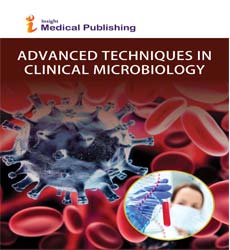Microbial Infection of Male System causing Infertility
Shaoping Huang*
Department of Histology and Embryology, Medical School, Southeast University, Nanjing 210009, Jiangsu, PR China
- Corresponding Author:
- Shaoping Huang, M.D
Department of Histology and Embryology
Medical School, Southeast University
Nanjing 210009, Jiangsu, PR China
Tel: +20 01115962724
Email: huangsp-8888@163.com
Received date: November 28, 2016; Accepted date: November 29, 2016; Published date: December 6, 2016
Citation: Huang S. Microbial Infection of Male System causing Infertility. Adv Tech Clin Microbiol. 2016, 1:1.
Copyright: © 2016 Huang S. This is an open-access article distributed under the terms of the Creative Commons Attribution License, which permits unrestricted use, distribution, and reproduction in any medium, provided the original author and source are credited.
Introduction
Nowdays, about 10-15% of the couples within childbearing age suffer from infertility [1,2]. In these infertile couples, about 50% related to male factor infertility. Male reproductive health is becoming a social issue; more and more scientists focus their studies on male subfertility or infertility [3]. Male fertility depends on normal spermatogenesis, which consists of three phases: self-renewal of spermatogonial stem cells and differentiation, meiotic division of spermatocytes, and spermiogenesis.
Spermatogenic cells are highly sensitive to environmental factors; abnormal spermatogenesis affected by deleterious factors may result in subfertility or infertility [4]. In the past decades, studies had reported that environmental factors are associated with spermatogenesis [5], these factors not only includes physical and chemical factors, but also includes microorganism infectious of the male system [6]. In the clinical, some pathogens, such as Chlamydia trachomatis, Neisseria gonorrhoeae, Mycoplasma genitalium, Trichomonas vaginalis, Herpes virus simplex, are highly related to male infertility [7,8]. Studies showed that about 15% of male fertility disorders are results from infectious and inflammation of male system [9]. The inflammatory microenvironment results from microorganism’s infection may induce abnormal spermatogenesis leading to infertility [10,11]. For example, C. trachomatis is one of the most common pathogens that cause sexually transmitted infections; nearly 50% of men who are infected with this organism develop asymptomatic infections [12]. Study showed Chlamydia infections may indirectly damage the sperm, leading to unqualified sperm parameters, DNA fragmentation and impair the acrosome reaction capacity [13]. Using the male C57BL/6 mice, experiments confirmed that Chlamydia muridarum infection disrupted seminiferous tubules, causing loss of germ cells, with the most severely affected tubules containing only Sertoli cells [14]. Herpes Simplex Virus, reduces populations of germ cells, affects mobility and morphology of spermatozoa [2]. Other pathogens, such as Ureaplasma spp., human papillomavirus, hepatitis B and hepatitis C viruses, have all been detected in semen from symptomatic and asymptomatic men, are associated with poor sperm quality and decreased sperm concentration and motility [15,16].
All these literatures indicated that studies about clinical microbiol infection will cast a light on the diagnosis and treatment of male infertility. As the male infertility is one of the most important social problems, the launch of this new journal ‘Advance techniques in Clinical Microbiology’ is of great significance in nowadays!
References
- Mortimer D (2000) The future of male infertility management and assisted reproduction technology. Hum Reprod 15: 98-110.
- Amirjannati N, Yaghmaei F, Akhondi MM, Nasiri M, Heidari-Vala H, et al. (2014) Molecular and serologic diagnostic approaches; the prevalence of herpes simplex in idiopathic men infertile. J Reprod Med 12: 327-334.
- Bonde JP (2010). Male reproductive organs are at risk from environmental hazards. Asian Journal of Andrology 12: 152-156.
- Huang S, Cui Y, Guo X, Wang L, Li S, et al. (2015) 2,2',4,4'-Tetrabromodiphenyl ether disrupts spermatogenesis, impairs mitochondrial function and induces apoptosis of early leptotene spermatocytes in rats. Reprod Toxicol 51: 114-124.
- Alshahrani S, McGill J, Agarwal A (2013) Prostatitis and male infertility. J Reprod Immunol 100: 30-36.
- Schagdarsurengin U, Western P, Steger K, Meinhardt A (2016) Developmental origins of male subfertility: Role of infection, inflammation and environmental factors. Semin Immunopathol 38: 765-781.
- Gimenes F, Medina FS, Abreu AL, Irie MM, Esquiçati IB, et al. (2014) Sensitive simultaneous detection of seven sexually transmitted agents in semen by multiplex-PCR and of HPV by single PCR. PLoS One 9: e98862.
- Mor A, Driggers PH, Segars JH (2015) Molecular characterization of the human microbiome from a reproductive perspective. Fertil Steril 104: 1344-1350.
- Autilio C, Morelli R, Milardi D, Grande G, Marana R, et al. (2015) Soluble urokinase-type plasminogen activator receptor as a putative marker of male accessory gland inflammation. Andrology 3: 1054-1061.
- Tremellen K (2008) Oxidative stress and male infertility – a clinical perspective. Hum Reprod Update 14: 243-258.
- Alshahrani S, McGill J, Agarwal A (2013) Prostatitis and male infertility. J Reprod Immunol 100: 30-36.
- Ahmadi MH, Mirsalehian A, Bahador A (2015) Prevalence of genital Chlamydia trachomatis in Iran: A systematic review and meta-analysis. Pathog Glob Health 109: 290-299.
- Cunningham KA, Beagley KW (2008) Male genital tract chlamydial infection: Implications for pathology and infertility. Biol Reprod 79: 180-189.
- Sobinoff AP, Dando SJ, Redgrove KA, Sutherland JM, Stanger SJ, et al. (2015) Chlamydia muridarum infection-induced destruction of male germ cells and sertoli cells is partially prevented by Chlamydia major outer membrane protein-specific immune CD4 cells. Biol Reprod 92: 27.
- Gimenes F, Souza RP, Bento JC, Teixeira JJ, Maria-Engler SS, et al. (2014) Male infertility: A public health issue caused by sexually transmitted pathogens. Nat Rev Urol 11: 672-687.
- Naumenko VA, Tiulenev IuA, Pushkar' DIu, Segal AS, Kovalev VA, et al. (2011) Effect of herpes simplex virus on spermatogenesis Urologiia, pp: 32-36.
Open Access Journals
- Aquaculture & Veterinary Science
- Chemistry & Chemical Sciences
- Clinical Sciences
- Engineering
- General Science
- Genetics & Molecular Biology
- Health Care & Nursing
- Immunology & Microbiology
- Materials Science
- Mathematics & Physics
- Medical Sciences
- Neurology & Psychiatry
- Oncology & Cancer Science
- Pharmaceutical Sciences
